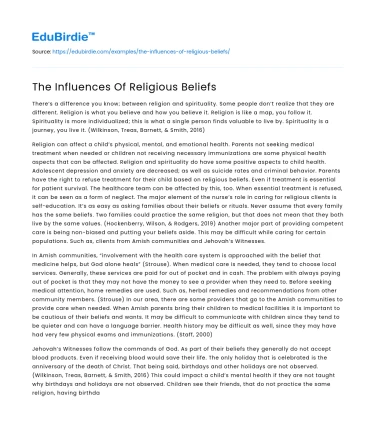There’s a difference you know; between religion and spirituality. Some people don’t realize that they are different. Religion is what you believe and how you believe it. Religion is like a map, you follow it. Spirituality is more individualized; this is what a single person finds valuable to live by. Spirituality is a journey, you live it. (Wilkinson, Treas, Barnett, & Smith, 2016)
Religion can affect a child’s physical, mental, and emotional health. Parents not seeking medical treatment when needed or children not receiving necessary immunizations are some physical health aspects that can be affected. Religion and spirituality do have some positive aspects to child health. Adolescent depression and anxiety are decreased; as well as suicide rates and criminal behavior. Parents have the right to refuse treatment for their child based on religious beliefs. Even if treatment is essential for patient survival. The healthcare team can be affected by this, too. When essential treatment is refused, it can be seen as a form of neglect. The major element of the nurse’s role in caring for religious clients is self-education. It’s as easy as asking families about their beliefs or rituals. Never assume that every family has the same beliefs. Two families could practice the same religion, but that does not mean that they both live by the same values. (Hockenberry, Wilson, & Rodgers, 2019) Another major part of providing competent care is being non-biased and putting your beliefs aside. This may be difficult while caring for certain populations. Such as, clients from Amish communities and Jehovah’s Witnesses.
Save your time!
We can take care of your essay
- Proper editing and formatting
- Free revision, title page, and bibliography
- Flexible prices and money-back guarantee
In Amish communities, “involvement with the health care system is approached with the belief that medicine helps, but God alone heals” (Strouse). When medical care is needed, they tend to choose local services. Generally, these services are paid for out of pocket and in cash. The problem with always paying out of pocket is that they may not have the money to see a provider when they need to. Before seeking medical attention, home remedies are used. Such as, herbal remedies and recommendations from other community members. (Strouse) In our area, there are some providers that go to the Amish communities to provide care when needed. When Amish parents bring their children to medical facilities it is important to be cautious of their beliefs and wants. It may be difficult to communicate with children since they tend to be quieter and can have a language barrier. Health history may be difficult as well, since they may have had very few physical exams and immunizations. (Staff, 2000)
Jehovah’s Witnesses follow the commands of God. As part of their beliefs they generally do not accept blood products. Even if receiving blood would save their life. The only holiday that is celebrated is the anniversary of the death of Christ. That being said, birthdays and other holidays are not observed. (Wilkinson, Treas, Barnett, & Smith, 2016) This could impact a child’s mental health if they are not taught why birthdays and holidays are not observed. Children see their friends, that do not practice the same religion, having birthday parties and celebrating holidays with their families; they may not understand why they cannot do the same. This may feel like a punishment to them.
Witnessing religions can be difficult. Since we did not get to go to the Aroostook County Action Program (ACAP), I did not experience this. In the videos that I did watch, I did not observe any religious preferences. In public schools, religion can be taught but cannot be promoted. This is different for private schools. Such as Christian private schools, “everything is Christ-centered with prayers and religious practices being part of the educational process” (Cornerstone Christian Academy, 2016).
References
- Cornerstone Christian Academy. (2016, March 18). What Makes a Christian Private School Different? Retrieved April 1, 2020, from https://welovecornerstone.com/christian-school/christian-private-school-different/
- Hockenberry, M. J., Wilson, D., & Rodgers, C. C. (2019). Wong’s nursing care of infants and children. St. Louis, MO: Elsevier.
- Staff, B. A. D. V. A. N. C. E. (2000, October 1). Amish Patients. Retrieved April 1, 2020, from https://www.elitecme.com/resource-center/nursing/amish-patients/
- Strouse, S. (n.d.). The health of the Amish. Retrieved April 1, 2020, from https://www.ohiosamishcountry.com/articles/the-health-of-the-amish
- Wilkinson, J. M., Treas, L. S., Barnett, K. L., & Smith, M. H. (2016). Fundamentals of nursing (3rd ed., Vol. 1). Philadelphia, PA: F.A. Davis.






 Stuck on your essay?
Stuck on your essay?

